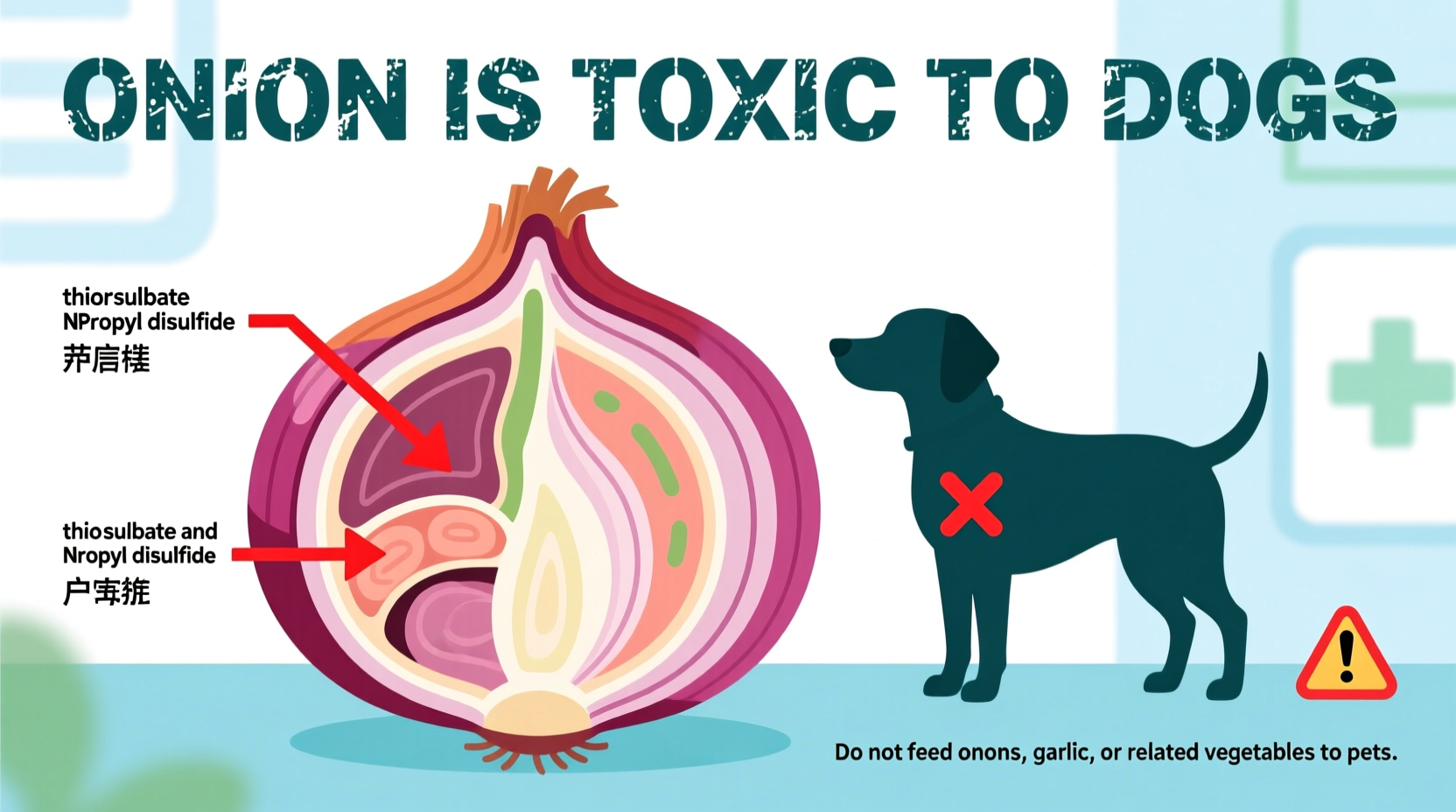Why Onions Pose a Serious Threat to Your Dog's Health
If your dog accidentally ate onions, you're right to be concerned. Onions contain N-propyl disulfide, a compound that damages red blood cells and leads to hemolytic anemia—a potentially fatal condition. This isn't just theoretical; veterinary clinics treat onion toxicity cases daily.
How Onion Toxicity Works: The Science Behind the Danger
When dogs consume onions, the N-propyl disulfide oxidizes hemoglobin in red blood cells, forming Heinz bodies—abnormal structures that make red blood cells fragile and prone to rupture. As these cells break down faster than the body can replace them, your dog develops anemia. Unlike humans, dogs lack sufficient enzymes to process these compounds safely.
| Dog Weight | Toxic Onion Amount | Severe Risk Level |
|---|---|---|
| 10 lbs (4.5 kg) | 1 oz (28g) | Life-threatening |
| 30 lbs (13.6 kg) | 3 oz (85g) | Life-threatening |
| 60 lbs (27.2 kg) | 6 oz (170g) | Life-threatening |
| Any size | Repeated small exposures | Chronic toxicity risk |
Source: American Society for the Prevention of Cruelty to Animals (ASPCA) Animal Poison Control Center
Recognizing Onion Poisoning Symptoms: What to Watch For
Symptoms typically appear 1-5 days after ingestion as damaged red blood cells accumulate. Watch for these critical warning signs:
- Weakness and lethargy (most common early symptom)
- Pale or yellow-tinged gums
- Dark red or brown urine
- Rapid breathing and heart rate
- Vomiting and diarrhea
- Collapse in severe cases
According to the Merck Veterinary Manual, even small repeated exposures—like daily table scraps containing onion powder—can cause chronic toxicity that's harder to diagnose but equally dangerous.
Immediate Action Plan: What to Do If Your Dog Eats Onions
Time is critical when dealing with onion toxicity. Follow these vet-recommended steps:
First 2 Hours After Ingestion
If you witnessed your dog eating onions and it's been less than two hours, contact your veterinarian immediately. They may instruct you to induce vomiting using 3% hydrogen peroxide (never use syrup of ipecac). Do not attempt this without professional guidance.
2-12 Hours After Ingestion
Activated charcoal administration may be recommended to absorb remaining toxins. Your vet will determine the appropriate dosage based on your dog's weight and the estimated onion consumption.
12+ Hours After Ingestion
Monitor closely for symptoms and schedule immediate blood work. Treatment may include oxygen therapy, IV fluids, and in severe cases, blood transfusions. The Pet Poison Helpline reports that approximately 25% of onion toxicity cases require hospitalization.

Preventing Onion Exposure: Practical Safety Measures
Prevention is always better than treatment. Implement these protective strategies:
- Secure food storage: Keep onions in closed cabinets, not on countertops
- Table scrap policy: Never feed human food containing onions, garlic, or chives
- Read labels: Check baby food and processed foods for onion powder (a common hidden ingredient)
- Garbage management: Use secured trash cans with locking lids
- Garden safety: Fence off areas where onions or related plants grow
Safe Flavor Alternatives for Your Dog's Meals
If you're preparing homemade meals for your dog, consider these safe flavor enhancers:
- Parsley (in moderation)
- Carrots (cooked or raw)
- Blueberries
- Green beans
- Unseasoned pumpkin
Remember that American Kennel Club research confirms all Allium family members—including garlic, leeks, chives, and shallots—pose similar risks to dogs. There is no safe amount of onion for canine consumption.
When to Consult Your Veterinarian: Don't Wait for Symptoms
Many pet owners make the critical mistake of waiting for symptoms to appear. By the time weakness or pale gums manifest, significant red blood cell damage has already occurred. If your dog consumed any amount of onion, contact your vet immediately—even if your pet seems fine. Early intervention dramatically improves outcomes.
Frequently Asked Questions About Onions and Dogs
Can dogs eat small amounts of onion?
No amount of onion is safe for dogs. Even small quantities can accumulate and cause toxicity over time. The American Veterinary Medical Association confirms there is no established safe threshold for onion consumption in dogs.
How long after eating onions will my dog show symptoms?
Symptoms typically appear 1-5 days after ingestion as damaged red blood cells accumulate. Early signs include weakness and lethargy, while advanced symptoms include pale gums and dark urine.
Is cooked onion safer than raw onion for dogs?
No. Cooking does not reduce onion toxicity. Both raw and cooked onions, as well as onion powder and juice, contain the same harmful compounds that damage red blood cells.
What should I do if my dog ate onion-containing food?
Contact your veterinarian immediately with details about what and how much was consumed. Do not wait for symptoms to appear. Bring the food packaging if possible to help your vet assess the risk level.
Are certain dog breeds more sensitive to onion toxicity?
Yes. Japanese breeds like Shiba Inus and Akita Inus show increased sensitivity to onion compounds according to veterinary toxicology studies. However, all dog breeds remain at risk regardless of size or breed.











 浙公网安备
33010002000092号
浙公网安备
33010002000092号 浙B2-20120091-4
浙B2-20120091-4